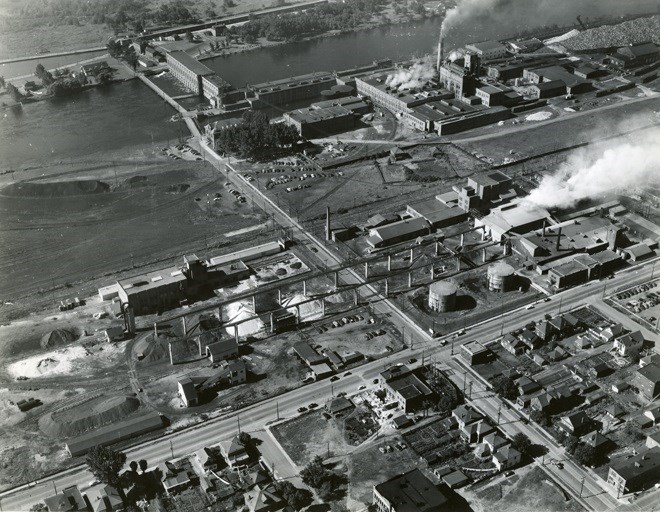From the archives of the Sault Ste. Marie Public Library:
Sault Ste. Marie’s Chromium Mining and Smelting Corporation plant was located on Queen Street West between Huron and Hudson, in the area of what is now the city’s transit facility.
The plant first began smelting chromium in in the 1930s, when it was the first instance of chromium smelting in the British Empire. From there, the plant quickly expanded to meet demand.
And then, in 1947, a fire roared through part of Sault Ste. Marie, originating from the plant.
Initial reports in the Globe and Mail described a “terrific blast” that “rocked the city,” shaking buildings as far away as eight blocks. However, it was soon determined that there was no explosion at all: instead, it was a chemically-fed, incredibly violent fire.
The chemical in question was D-Sulf-X, a substance presumably used in the plant’s experimental laboratory, where the fire initially started. D-Sulf-X was “believed to burn with greater intensity in water,” proving a challenge for firefighters. The fire chief was quoted in the Sault Star as saying that, “It was impossible to put the fire out . . . and all we could do was to prevent the flames from spreading.”
Fortunately, the wind helped keep the fire away from more populated, high-traffic parts of Sault Ste. Marie. Quick action to shut off gas lines also prevented further damage. However, the fire still burned with what Chromium Plant workers described as a “heat . . . so terrific it was almost unbearable.”
It was bright enough to be seen from across the river.
Within a day, most of the flames were put out, save for a few smaller fires. Once the immediate threat was halted, crews could get a better assessment of the damage, which was estimated at $30,000 – over $400,000 by today’s standards.
The laboratory building itself was completely destroyed, “melted and twisted by the intense heat.”
Next door, at the New Ontario Hotel, windows were broken, and the flames climbed as high as the third floor. The heat caused the death of two canaries, trapped in a cage in one of the rooms. Nearby residents found their possessions ruined as the fire ripped through their homes, with one woman telling the Globe and Mail, “If the fire had lasted another 10 minutes I am sure there would be no buildings left on this street.”
Stories also emerged of incredible escapes. One woman found herself trapped in her home, with both exits engulfed in flames; her husband ran through the flames to rescue her. In another case, a three-year-old boy was playing nearby. He tripped trying to flee the blaze and had to be carried to safety by some older friends, who described the heat as “something awful.”
Two canaries aside, there were no fatalities as a result of the fire: just a lot of fire damage and a shaken-up city.
Each week, the Sault Ste. Marie Public Library and its Archives provides SooToday readers with a glimpse of the city’s past.
Find out more of what the Public Library has to offer at www.ssmpl.ca and look for more Remember This? columns here
